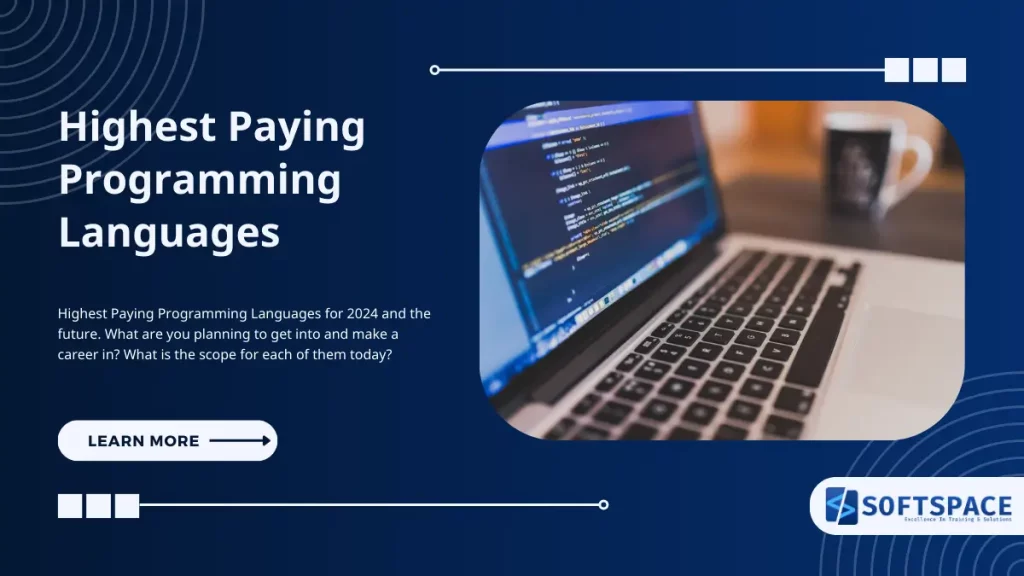Are you a coding enthusiast looking to unlock financial success? If so, you’re in the right place! In this article, we will explore the top 10 highest paying programming languages that can skyrocket your career in the tech industry. From Python to Java, Ruby to C#, each programming language is ranked based on their salary potential, demand in the job market, and future growth prospects.
In today’s digital world, the demand for skilled programmers is skyrocketing. As companies race to innovate and stay ahead of the competition, the need for talented software developers and engineers is at an all-time high. By mastering one or more of these high-paying programming languages, you’ll not only open doors to exciting job opportunities but also command an impressive paycheck.
Whether you’re a seasoned programmer or just starting your coding journey, this article has got you covered. We’ll provide insights into the average salaries, job market trends, and emerging opportunities for each programming language. So, let’s dive in and discover how you can unlock financial success with your coding skills!
- Highest Paying Programming Languages in 2024
- #1: Solidity
- #2: Erlang
- #3: Clojure
- #4: Scala
- #5: Perl
- #6: Ruby
- #7: JavaScript
- #8: Python
- #9: Java
- #10: Kotlin
- #11: Swift
- #12: C and C++
- #13: PHP
- #14: R Language
- #15: Golang
- How to Choose the Right Programming Language?
- Conclusion: Unlocking Financial Success with Your Coding Skills
Highest Paying Programming Languages in 2024
Before we delve into the top highest paying programming languages, it’s important to understand the factors that contribute to their salary potential. While demand and job market trends play a significant role, other aspects such as complexity, industry focus, and experience level also influence the earning potential of a programming language.
- Demand in the Job Market: The demand for programmers proficient in a particular language affects its salary potential. Languages that are widely used across various industries and sectors tend to offer higher salaries due to the increased competition for skilled professionals.
- Complexity and Specialization: The complexity of a programming language can also impact its salary potential. Languages that are more difficult to learn and require specialized skills often command higher salaries as there are fewer professionals proficient in those languages.
- Industry Focus: Different programming languages are more prevalent in specific industries. For example, Python is widely used in data science and machine learning, while JavaScript is popular for web development. The salary potential of a language may vary depending on the industry’s demand for that particular skill set.
- Experience Level: The level of experience and expertise a programmer has in a specific language can also influence their earning potential. Developers with several years of experience and a deep understanding of a language’s intricacies can demand higher salaries.
With these factors in mind, let’s explore the top 10 highest paying programming languages that can unlock financial success for you!
| Sr No. | Language | India (INR/year) | USA (USD/year) |
|---|---|---|---|
| #1 | Solidity | 8,00,000 – 18,00,000 | 100,000 – 160,000 |
| #2 | Erlang | 7,00,000 – 15,00,000 | 95,000 – 140,000 |
| #3 | Clojure | 7,50,000 – 16,00,000 | 100,000 – 150,000 |
| #4 | Scala | 8,00,000 – 17,00,000 | 110,000 – 160,000 |
| #5 | Perl | 5,00,000 – 11,00,000 | 75,000 – 115,000 |
| #6 | Ruby | 6,00,000 – 14,00,000 | 85,000 – 130,000 |
| #7 | JavaScript | 5,50,000 – 13,00,000 | 80,000 – 125,000 |
| #8 | Python | 6,00,000 – 14,00,000 | 85,000 – 130,000 |
| #9 | Java | 6,50,000 – 15,00,000 | 90,000 – 135,000 |
| #10 | Kotlin | 6,00,000 – 14,00,000 | 85,000 – 130,000 |
| #11 | Swift | 6,50,000 – 15,00,000 | 90,000 – 140,000 |
| #12 | C & C# | 6,00,000 – 14,00,000 | 85,000 – 130,000 |
| #13 | PHP | 4,50,000 – 10,00,000 | 70,000 – 110,000 |
| #14 | R Language | 5,50,000 – 12,00,000 | 80,000 – 120,000 |
| #15 | Go Lang | 7,00,000 – 16,00,000 | 95,000 – 140,000 |
#1: Solidity
Solidity is a high-level programming language designed for developing smart contracts that run on the Ethereum Virtual Machine (EVM). It’s a statically typed, object-oriented language with syntax inspired by C++, Python, and JavaScript.
Average Salary: Solidity developers, specializing in blockchain and smart contracts, usually earn between $90,000 to $150,000, or ₹75,00,000 to ₹1,20,00,000 in India.
Job Market Outlook: With the growth of blockchain technologies and decentralized finance (DeFi), Solidity developers are in high demand. As blockchain continues to evolve, the job market for Solidity developers will expand rapidly.
Emerging Opportunities: Solidity developers have huge opportunities in decentralized finance (DeFi), NFT platforms, and the development of smart contracts as the blockchain ecosystem rapidly expands.
#2: Erlang
Erlang is a general-purpose, concurrent, functional programming language designed for building massively scalable, distributed, and fault-tolerant systems. Developed by Ericsson in the 1980s, Erlang has been widely adopted in industries such as telecommunications, e-commerce, and banking.
Average Salary: Erlang developers, often working in telecommunications and distributed systems, earn between $80,000 to $120,000, translating to ₹66,00,000 to ₹1,00,00,000 in India.
Job Market Outlook: Erlang is specialized in telecommunications, real-time systems, and distributed computing. The job market is niche but stable, with demand primarily in sectors that require high-reliability systems.
Emerging Opportunities: Emerging opportunities for Erlang developers include building fault-tolerant systems for messaging platforms, scalable real-time applications, and telecom networks, especially in the growing area of 5G infrastructure.
#3: Clojure
Clojure is a dynamic programming language that combines the functional programming paradigm with the JVM platform. It is a dialect of Lisp, known for its expressive syntax and powerful metaprogramming capabilities.
Average Salary: Clojure developers, known for their functional programming skills, typically earn $100,000 to $140,000 annually, which is around ₹83,00,000 to ₹1,15,00,000 in India.
Job Market Outlook: Clojure, a functional programming language, is gaining traction in areas like big data and cloud services. While the market is niche, its functional nature appeals to companies looking for robust and scalable solutions, leading to steady demand.
Emerging Opportunities: Clojure is seeing emerging opportunities in fintech, data-driven applications, and AI-driven systems, where functional programming is valued for reliability and scalability.
#4: Scala
Scala is a general-purpose programming language that combines object-oriented and functional programming paradigms. It is designed to be both expressive and concise, while also offering strong type safety and performance.
Average Salary: Scala developers, working in areas like big data and functional programming, earn between $100,000 to $140,000 per year, or ₹83,00,000 to ₹1,15,00,000 in India.
Job Market Outlook: Scala is widely used in data processing frameworks like Apache Spark. With the growth of big data and machine learning, the demand for Scala developers is rising, particularly in the data science and backend development sectors.
Emerging Opportunities: Scala developers have emerging opportunities in big data analytics, machine learning, and distributed systems through frameworks like Apache Spark, especially in the data-driven sectors.
#5: Perl
Perl, a high-level programming language, is renowned for its flexibility and power. Created by Larry Wall in the early 1990s, Perl was initially designed to be a system administration language but quickly evolved into a versatile tool for a wide range of tasks.
Average Salary: Perl developers, known for their work in text processing and system administration, typically earn an annual salary ranging from $80,000 to $120,000, which is approximately ₹66,00,000 to ₹1,00,00,000 in India.
Job Market Outlook: Perl is still used in system administration, network programming, and legacy systems. While its job market is shrinking due to newer technologies, there is still demand for maintaining older systems and automation roles within certain industries.
Emerging Opportunities: Although Perl’s prominence is declining, emerging opportunities include automation in system administration, network security, and DevOps pipelines, particularly in legacy system integration and migration projects.
#6: Ruby
Ruby, a high-level, interpreted programming language, is known for its elegance, simplicity, and object-oriented nature. Created by Yukihiro Matsumoto in the mid-1990s, Ruby was designed to be a pleasure to use, emphasizing developer happiness and productivity.
Average Salary: Ruby developers, primarily in web development, usually earn $90,000 to $130,000 annually, equivalent to ₹75,00,000 to ₹1,08,00,000 in India.
Job Market Outlook: Ruby, known for web development through the Ruby on Rails framework, is still popular in startups and small to mid-sized businesses. Although its market share has declined compared to JavaScript and Python, there’s steady demand in niche areas.
Emerging Opportunities: Ruby developers find emerging opportunities in cloud-based services, API development, and DevOps automation, as well as in maintaining and scaling applications in tech startups.
#7: JavaScript
JavaScript has become a staple in modern web development and is widely used to create interactive and dynamic websites. Its versatility and compatibility across different platforms make it a highly sought-after skill in the job market. JavaScript developers are in high demand, especially with the rise of frameworks like React and Angular.
Average Salary: JavaScript developers earn an average annual salary ranging from $90,000 to $140,000, which is approximately ₹75,00,000 to ₹1,15,00,000 in India, depending on experience and location.
Job Market Outlook: JavaScript continues to be one of the most in-demand programming languages, with job opportunities spanning across industries such as web development, mobile app development, and even server-side development with Node.js.
Emerging Opportunities: As the demand for web applications and mobile apps continues to grow, JavaScript developers can explore opportunities in emerging technologies such as Progressive Web Apps (PWAs), hybrid mobile app development, and Internet of Things (IoT) development.
#8: Python
Python has gained immense popularity in recent years, thanks to its simplicity, readability, and extensive libraries and frameworks. Python is widely used in preparing for a career in data science, scientific computing, artificial intelligence, and machine learning. Its versatility and ease of use make it a favorite among both beginners and experienced developers.
Average Salary: Python developers typically receive salaries between $90,000 to $150,000, or ₹75,00,000 to ₹1,20,00,000 in India, with demand being high in data science and web development.
Job Market Outlook: Python’s job market outlook is incredibly promising. It is the go-to language to get jobs as a data analyst, data scientist, and machine learning engineer. Its applications extend to web development, automation, and scripting. The demand for Python developers is expected to continue growing in the foreseeable future
Emerging Opportunities: With the rise of artificial intelligence and machine learning, Python developers can explore opportunities in data analysis, natural language processing, and computer vision. Additionally, Python’s integration with frameworks like Django and Flask opens doors to lucrative web development projects. To get skilled in this profile, you can check our Data Science Course which offers comprehensive training and job opportunities.
#9: Java
Java is a versatile and robust programming language that has stood the test of time. It is widely used for building enterprise-level applications, Android app development, and server-side development. Java’s popularity lies in its platform independence, vast libraries, and strong community support.
Average Salary: Java developers, who often work in large enterprises, earn between $100,000 to $130,000 annually, translating to ₹83,00,000 to ₹1,08,00,000 in India.
Job Market Outlook: Java continues to be a dominant force in the job market, particularly in enterprise-level development and Android app development. The demand for Java developers remains strong, and the language’s versatility ensures a wide range of job opportunities.
Emerging Opportunities: Java developers can explore emerging trends such as microservices architecture, cloud-native development, and serverless computing. Additionally, Java’s compatibility with frameworks like Spring and Hibernate provides avenues for specialization and higher-paying positions.
#10: Kotlin
Kotlin, a programming language developed by JetBrains, has gained significant traction in recent years, particularly in Android app development. Kotlin offers more concise syntax, null safety, and seamless interoperability with Java, making it an attractive alternative to Java for Android development.
Average Salary: Kotlin developers, particularly in Android development, earn an average salary of $100,000 to $130,000, which is about ₹83,00,000 to ₹1,08,00,000 in India.
Job Market Outlook: The demand for Kotlin developers has been steadily increasing, especially with Google announcing Kotlin as the preferred language for Android app development. Kotlin’s popularity ensures a steady stream of job opportunities in the Android development ecosystem.
Emerging Opportunities: Kotlin developers can explore opportunities in cross-platform app development using frameworks like Flutter and React Native. Additionally, Kotlin’s compatibility with Java allows developers to work on existing Java projects and gradually migrate them to Kotlin.
#11: Swift
Swift, developed by Apple, is the programming language of choice for iOS, macOS, watchOS, and tvOS app development. Swift offers a modern and concise syntax, memory safety, and performance optimizations, making it a powerful language for developing applications across Apple’s ecosystem.
Average Salary: Swift developers, primarily working on iOS applications, can expect salaries ranging from $100,000 to $130,000, or ₹83,00,000 to ₹1,08,00,000 in India.
Job Market Outlook: With Apple’s continued focus on the iOS ecosystem and the growing popularity of macOS, watchOS, and tvOS, the demand for Swift developers remains strong. The job market for Swift developers offers exciting opportunities in mobile app development and Apple platform-specific projects.
Emerging Opportunities: Swift developers can explore opportunities in augmented reality (AR) and virtual reality (VR) development using Apple’s ARKit and RealityKit frameworks. Additionally, Swift’s compatibility with Objective-C allows developers to work on existing iOS projects and gradually transition to Swift.
#12: C and C++
C and C++ are powerful and widely used programming languages that form the backbone of system-level programming, game development, and embedded systems. While C++ offers additional features and object-oriented programming capabilities compared to C, both languages remain crucial in various domains.
Average Salary: C and C++ developers, who are crucial for systems programming, typically earn $90,000 to $120,000 per year, equivalent to ₹75,00,000 to ₹1,00,00,000 in India.
Job Market Outlook: The demand for C and C++ developers persists in areas such as game development, operating system development, and embedded systems. While newer languages have emerged, these languages continue to be relevant due to their low-level capabilities and high performance.
Emerging Opportunities: C and C++ developers can explore opportunities in emerging fields such as the Internet of Things (IoT), virtual reality (VR), and autonomous systems. Additionally, game development studios and companies working on high-performance computing often require expertise in C and C++.
#13: PHP
PHP is a server-side scripting language widely used for web development. It powers popular content management systems (CMS) like WordPress and Drupal and offers extensive libraries and frameworks for building dynamic websites and web applications.
Average Salary: PHP developers, working in web development, usually earn between $70,000 to $110,000 annually, which translates to ₹58,00,000 to ₹91,00,000 in India.
Job Market Outlook: While PHP faces competition from newer languages and frameworks, it remains a popular choice for web development, especially in small to medium-sized projects. The job market for PHP developers continues to offer a steady flow of opportunities.
Emerging Opportunities: PHP developers can explore opportunities in e-commerce development using popular frameworks like Laravel and Magento. Additionally, PHP’s integration with JavaScript libraries and frameworks allows developers to create modern and interactive web applications.
#14: R Language
R is a programming language and environment commonly used for statistical computing, data analysis, and machine learning. R boasts a vast collection of packages and libraries specifically designed for data manipulation, visualization, and statistical modeling.
Average Salary: R Language developers, often specializing in data analytics and statistics, can expect salaries between $80,000 to $120,000, or ₹66,00,000 to ₹1,00,00,000 in India.
Job Market Outlook: With the growing importance of data analysis and machine learning in various industries, the demand for R developers is on the rise. R is widely used in sectors such as finance, healthcare, and marketing, ensuring a plethora of job opportunities.
Emerging Opportunities: R developers can explore opportunities in the fields of data science, artificial intelligence, and predictive analytics. Additionally, R’s integration with popular frameworks like TensorFlow and Keras allows developers to leverage deep learning capabilities.
#15: Golang
Golang, also known as Go, is a statically typed, compiled programming language developed by Google. Go is known for its simplicity, efficiency, and built-in support for concurrent programming. It is widely used in server-side and cloud-native development.
Average Salary: Golang developers, working in high-performance backend systems, typically earn $100,000 to $150,000 per year, which is ₹83,00,000 to ₹1,20,00,000 in India.
Job Market Outlook: The demand for Golang developers has been growing steadily, particularly in areas such as microservices architecture, cloud-native development, and distributed systems. Go’s performance and simplicity make it an attractive choice for building scalable and efficient applications.
Emerging Opportunities: Golang developers can explore emerging trends such as containerization (e.g., Docker, Kubernetes), serverless computing, and blockchain development. Additionally, Go’s compatibility with popular frameworks like Gin and Echo opens doors to high-performance web development projects.
How to Choose the Right Programming Language?
Choosing the right programming language for your career goals is crucial for unlocking financial success. Here are some factors to consider when making your decision:
- Interest and Passion: Choose a programming language that aligns with your interests and passion. Enjoying the language you work with will make your coding journey more enjoyable and fulfilling.
- Job Market Demand: Consider the current and future job market demand for a particular programming language. Choose a language with a promising job market outlook to ensure a steady stream of opportunities.
- Industry Focus: Assess the industries and sectors where a programming language is widely used. Choose a language that aligns with your desired industry to increase your chances of landing lucrative job opportunities.
- Learning Curve: Evaluate the learning curve of a programming language based on your current skill level and available resources. Choose a language that you find manageable to learn and master.
- Future Growth Prospects: Consider the future growth prospects of a programming language. Look for emerging trends, technologies, and frameworks associated with the language that can open doors to new opportunities.
By carefully considering these factors, you can make an informed decision and choose a programming language that aligns with your career goals and unlocks financial success.
Conclusion: Unlocking Financial Success with Your Coding Skills
In today’s digital age, coding skills have become a valuable asset that can unlock financial success. By mastering one or more of the top 10 highest paying programming languages, you can position yourself for lucrative job opportunities and command impressive salaries.
From JavaScript to Python, Java to Kotlin, each programming language offers its unique advantages and opportunities. Whether you’re interested in web development, data science, mobile app development, or system-level programming, there is a programming language that suits your career aspirations.
Remember, financial success is not solely determined by the programming language you choose but also by your dedication, continuous learning, and problem-solving abilities. So, invest your time and effort in honing your coding skills, stay abreast of industry trends, and embrace opportunities for professional growth. With the right mindset and skills, you can unlock a world of financial success in the ever-evolving tech industry. So, go ahead and embark on your coding journey today!

13+ Yrs Experienced Career Counsellor & Skill Development Trainer | Educator | Digital & Content Strategist. Helping freshers and graduates make sound career choices through practical consultation. Guest faculty and Digital Marketing trainer working on building a skill development brand in Softspace Solutions. A passionate writer in core technical topics related to career growth.





